developer productivity tools
developer tools
productivity tools
software development
coding tools
Top Developer Productivity Tools for 2025
Unlocking Developer Superpowers: Essential Tools for 2025
As a developer, your time is valuable. This listicle provides a curated list of 12 essential developer productivity tools for 2025. These tools will streamline your workflow and boost your coding efficiency. We'll explore how these solutions address common development pain points, allowing you to focus on building exceptional software.
This list dives deep into practical use cases and real-world insights. We'll go beyond surface-level reviews, providing an honest assessment of each tool's strengths and limitations. You'll learn how to integrate these tools effectively into your workflow, maximizing their potential. Whether you are an independent developer, a startup founder, or part of a larger team, these tools offer practical solutions to your everyday development challenges.
This listicle covers the following developer productivity tools:
- AI-powered coding assistants (GitHub Copilot, Tabnine)
- Integrated development environments (Visual Studio Code)
- Project management platforms (ClickUp, Jira, Trello, Notion)
- Containerization tools (Docker)
- Design tools (Figma)
- API development platforms (Postman)
- Communication and collaboration platforms (Slack)
- Code wrapping tools (AnotherWrapper)
We will cover key features, practical use cases, pricing, and integration tips. Ready to unlock your developer superpowers? Let's dive in.
1. AnotherWrapper
AnotherWrapper accelerates AI micro SaaS development. It provides a starter kit built on Next.js 15 and TypeScript. This includes over 12 customizable AI demo apps, from chatbots and image generation to PDF Q&A and speech-to-text. Leveraging models like GPT-4o, DALL·E 3, and Claude 3.7, AnotherWrapper integrates with Supabase for backend services. This empowers developers to focus on product innovation rather than repetitive setup.
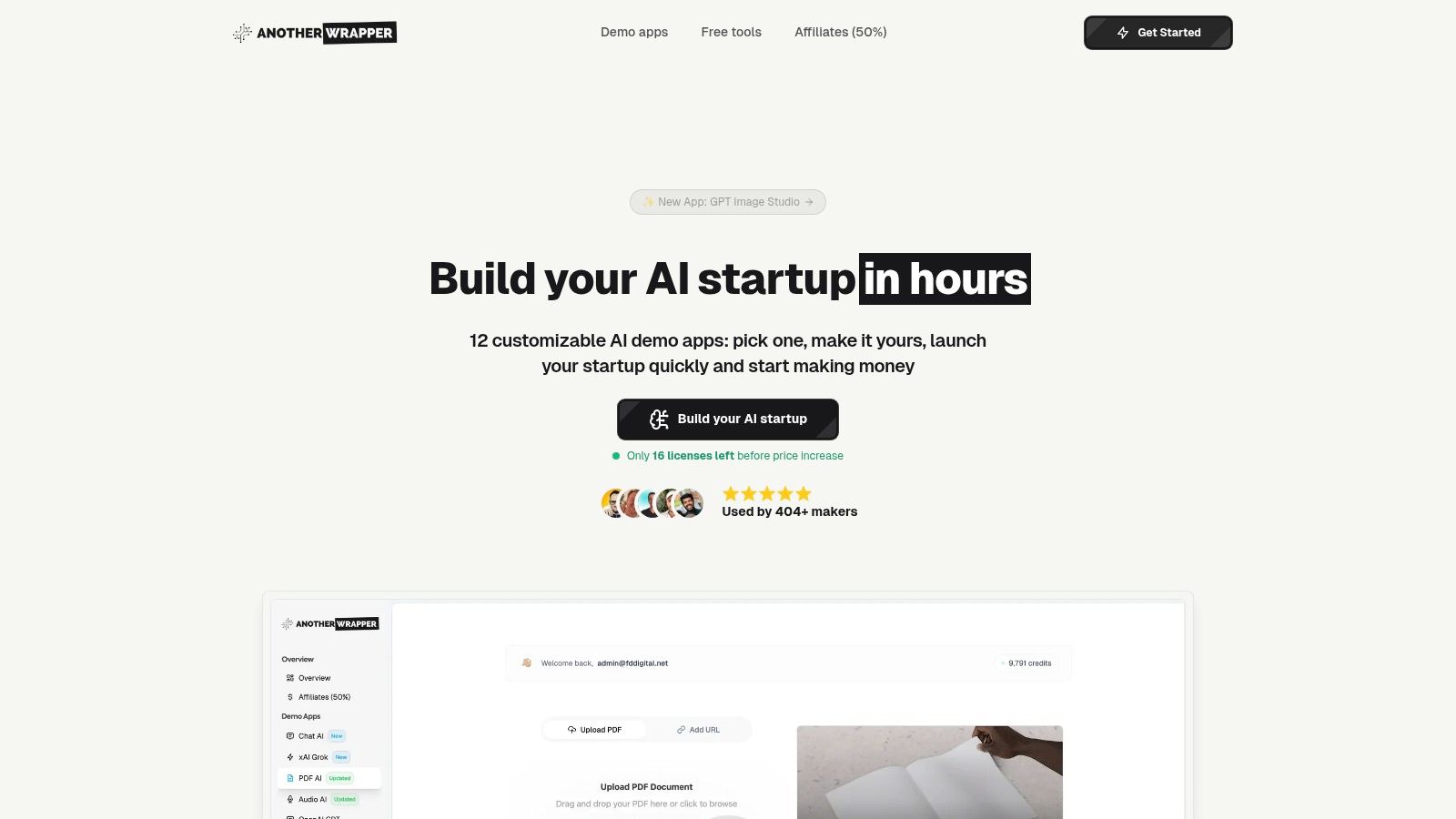
Its UI toolkit, with 40+ Tailwind CSS themes and 15+ UI components, facilitates rapid and visually appealing app development. The one-time payment model ($229-$549) offers significant value compared to agency development or recurring subscriptions, especially for launching multiple projects. However, some Next.js and TypeScript familiarity is beneficial for maximizing customization.
Practical Applications
- Rapid Prototyping: Quickly build and test AI-powered MVPs.
- Micro SaaS Launches: Launch niche AI tools in a fraction of the time.
- Portfolio Expansion: Diversify your SaaS offerings with various AI applications.
Pros and Cons
Pros:
- Reduced Development Time
- Diverse AI Model Support
- Comprehensive Integrations
- Powerful UI Toolkit
- Cost-Effective Licensing
Cons:
- Requires Next.js/TypeScript knowledge
- Premium pricing may be a barrier for some
Implementation Tips
Start with the demo apps to understand the codebase. Customize the UI with Tailwind CSS and explore Supabase integration for backend functionality. Leverage the provided landing page variants to accelerate your launch.
AnotherWrapper is a strong developer productivity tool. It considerably shortens the development lifecycle for AI-powered applications. Visit their website: https://anotherwrapper.com
2. GitHub Copilot
GitHub Copilot significantly boosts developer productivity as an AI-powered code completion tool. Developed by GitHub and OpenAI, it integrates seamlessly with Visual Studio Code. This offers real-time code suggestions and autocompletions based on the surrounding code context. This helps developers write code faster and with fewer errors, streamlining the development process.

Copilot supports a wide range of programming languages, making it versatile for various projects. Its context-aware suggestions go beyond simple autocompletion, often suggesting entire functions or code blocks. This can drastically reduce the time spent on repetitive coding tasks. For developers exploring AI-powered micro SaaS ideas, GitHub Copilot can be a valuable tool. Learn more about those ideas here: Learn more about GitHub Copilot and micro SaaS ideas. However, it's important to note that Copilot requires an active internet connection for optimal performance.
Practical Applications
- Boilerplate Code Reduction: Quickly generate common code snippets and structures.
- Code Quality Improvement: Receive intelligent suggestions for better code practices.
- Faster Development Cycles: Write code more efficiently and reduce debugging time.
Pros and Cons
Pros:
- Increased Coding Speed
- Improved Code Quality
- Wide Language Support
Cons:
- Potential for Inaccurate Suggestions
- Requires Internet Connection
Implementation Tips
Install the GitHub Copilot extension in Visual Studio Code. Begin by using it for simple tasks and gradually explore its capabilities for more complex code generation. Double-check suggested code for accuracy and security before implementation.
3. Visual Studio Code (VS Code)
Visual Studio Code (VS Code) is a free, open-source code editor developed by Microsoft. It offers powerful features like debugging, syntax highlighting, intelligent code completion, snippets, and refactoring. Its highly extensible architecture, supported by a vast marketplace of extensions, makes it adaptable to diverse development workflows. This flexibility makes VS Code a popular choice among developers of all skill levels.
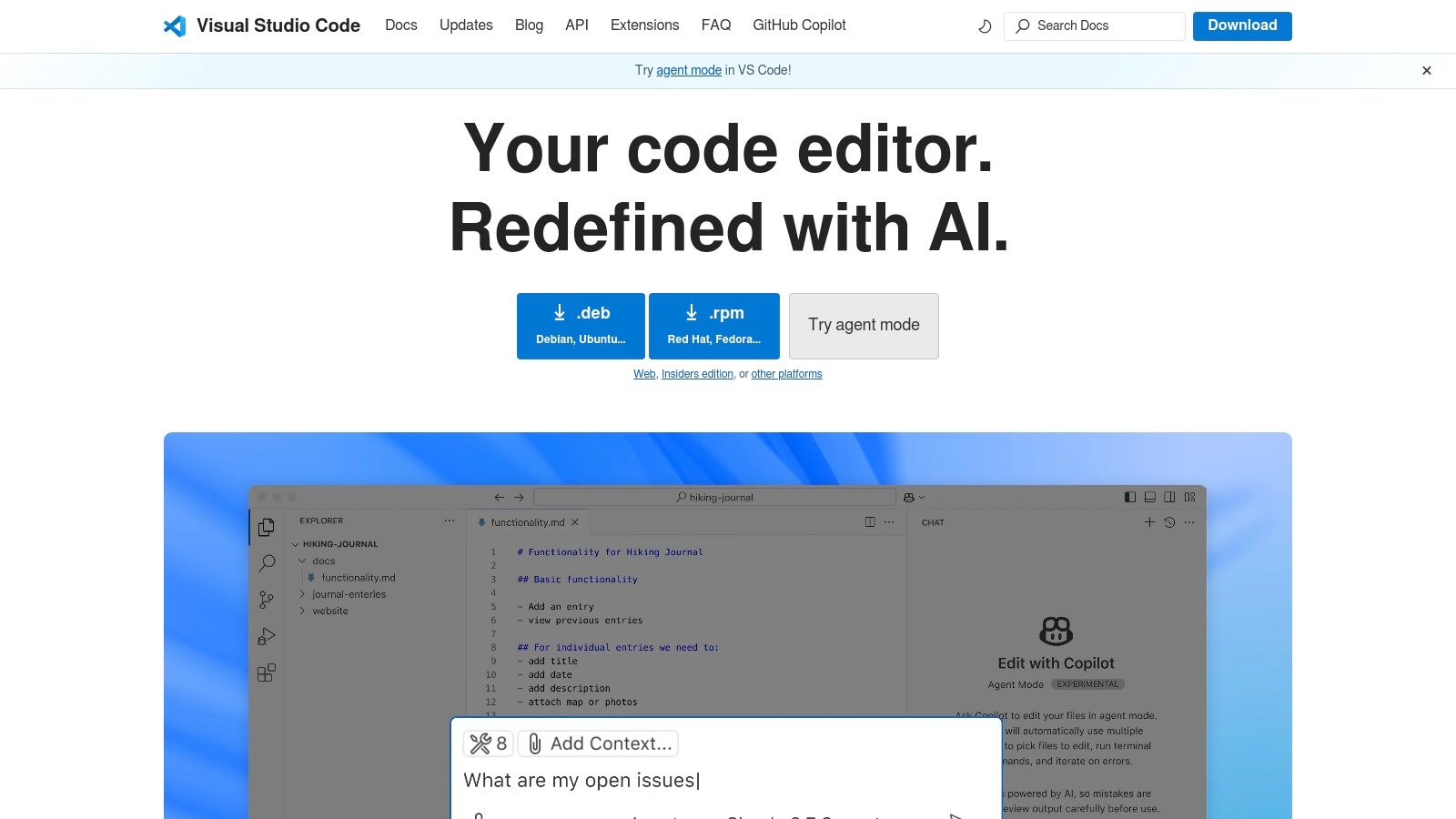
VS Code's built-in Git commands, integrated terminal, and support for multiple programming languages streamline the development process. Customizable themes and layouts allow developers to personalize their coding environment. The extensive extension marketplace offers tools for virtually any task, from specialized language support to advanced debugging tools. This level of customization and extensibility contributes significantly to developer productivity.
Practical Applications
- Web Development: Build websites and web apps with support for HTML, CSS, JavaScript, and various frameworks.
- Software Development: Develop applications in languages like Python, Java, C++, and more.
- Data Science: Utilize extensions for data analysis, visualization, and machine learning.
Pros and Cons
Pros:
- Highly Customizable and Extensible
- Lightweight and Fast Performance
- Strong Community Support
- Free and Open-Source
Cons:
- Can Consume Significant Memory with Multiple Extensions
- Initial Setup Can Require Time for Customization
Implementation Tips
Start by installing essential extensions for your specific workflows. Explore the available themes and customize the layout to optimize your coding environment. Leverage the integrated terminal and Git commands for efficient development. VS Code is a powerful tool that can significantly enhance developer productivity when properly configured.
Visual Studio Code is a versatile and powerful code editor suitable for a wide range of development tasks. Its extensibility and customizability make it a valuable tool for boosting developer productivity. Visit their website: https://code.visualstudio.com/
4. ClickUp
ClickUp is a comprehensive project management and productivity tool that combines task management, collaboration, and workflow automation in one platform. It's designed to help teams organize work, track progress, and boost overall productivity. Its highly customizable nature makes it adaptable to diverse workflows, from agile development to content creation. For developers specifically, ClickUp offers robust features for sprint management, bug tracking, and release planning.

ClickUp's extensive feature set includes customizable views (list, board, Gantt, calendar), real-time collaboration tools, time tracking, and reporting. It integrates with over 1,000 other work tools, creating a centralized hub for all project-related activities. While the free plan offers generous features, paid plans unlock advanced functionalities like dashboards, custom fields, and increased storage. However, its extensive features can also lead to a steeper learning curve, especially for smaller teams or individual developers.
Practical Applications
- Sprint Management: Organize tasks, assign team members, and track progress within sprints.
- Bug Tracking: Log, prioritize, and manage bugs throughout the development lifecycle.
- Release Planning: Coordinate tasks, dependencies, and timelines for software releases.
Pros and Cons
Pros:
- Highly customizable workflows
- Comprehensive project management features
- Extensive integrations
- Robust free plan
Cons:
- Steeper learning curve
- Can feel overwhelming for some users
Implementation Tips
Start with a simplified project structure and gradually add complexity. Explore the various view options to find the best fit for your workflow. Utilize custom fields to track specific development metrics. Leverage integrations to connect ClickUp with other tools in your development stack.
ClickUp is a powerful developer productivity tool for managing complex projects and streamlining workflows. Its flexibility and comprehensive features make it a valuable asset for development teams of all sizes. Visit their website: https://clickup.com/
5. Jira
Jira is a project and issue-tracking software developed by Atlassian. It's widely used by agile development teams for planning, tracking, and releasing software. Its robust tracking and collaboration features make it a central hub for managing the entire development lifecycle. From initial sprint planning to final release, Jira helps teams stay organized and on track.
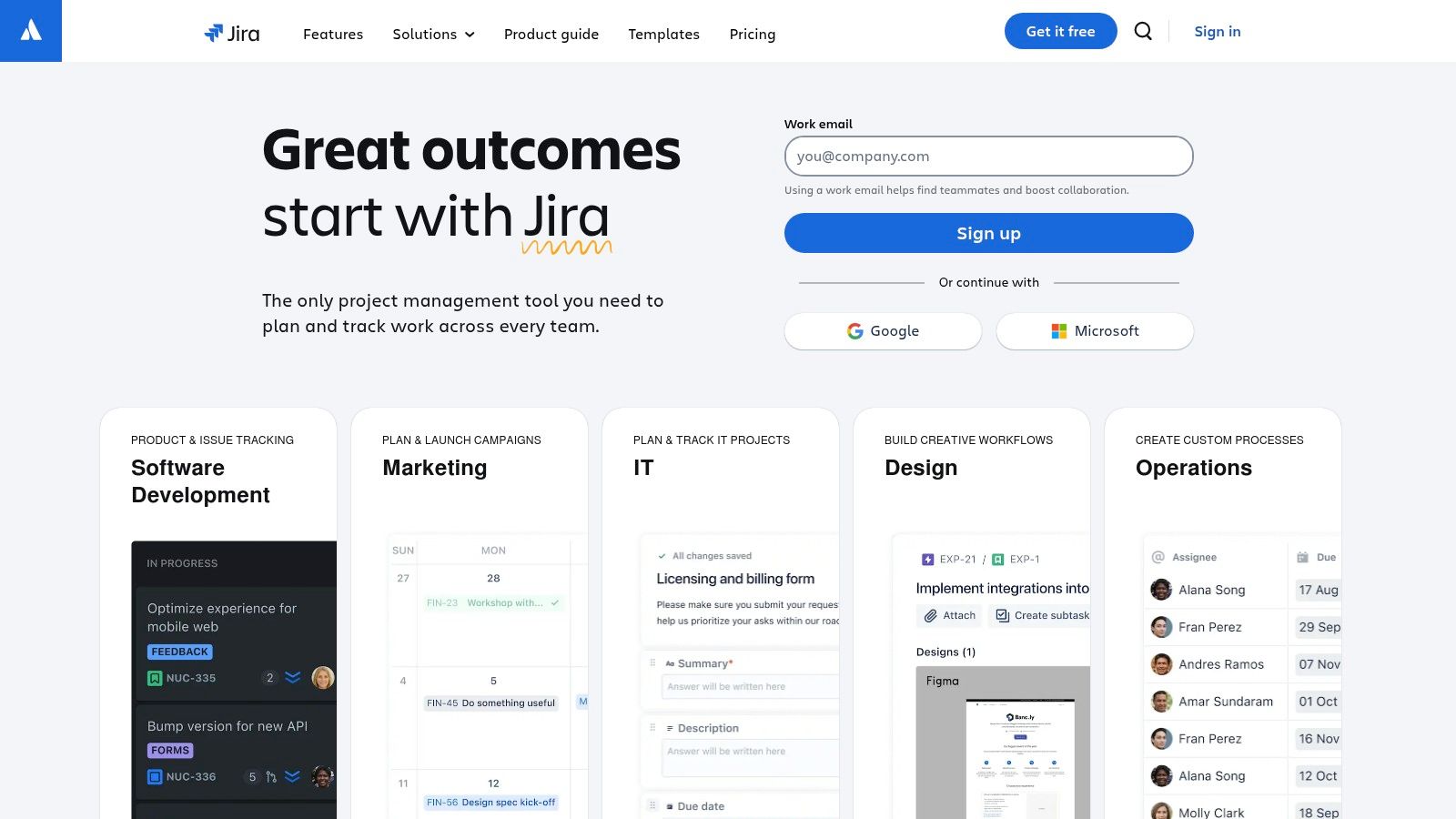
Jira’s customizable workflows, Kanban and Scrum boards, and advanced reporting provide a tailored experience for various project needs. Its integration with various development tools, like code repositories and CI/CD pipelines, streamlines the development process. While its extensive features offer powerful project management capabilities, they can also be overwhelming for new users. The pricing, which scales with the number of users, might also present a challenge for larger teams. Learn more about Jira and task management.
Practical Applications
- Agile Development: Manage sprints, track progress, and facilitate collaboration.
- Bug Tracking: Report, track, and resolve bugs efficiently.
- Project Management: Plan, organize, and execute projects of varying complexities.
Pros and Cons
Pros:
- Highly customizable workflows
- Strong integration capabilities
- Comprehensive reporting features
Cons:
- Steep learning curve for new users
- Pricing can be high for larger teams
Implementation Tips
Start with a basic project and gradually explore advanced features as needed. Utilize pre-built templates to quickly set up common project types. Integrate with existing development tools to streamline workflows. Consider dedicated training for team members to maximize Jira's potential. Jira is a powerful tool for developer productivity, but its complexity requires a strategic implementation approach.
6. Docker
Docker streamlines application development by packaging software and its dependencies into portable containers. This ensures consistency across different environments, from development to production. Docker simplifies dependency management and promotes efficient deployment, making it a valuable tool for developers working on complex projects.
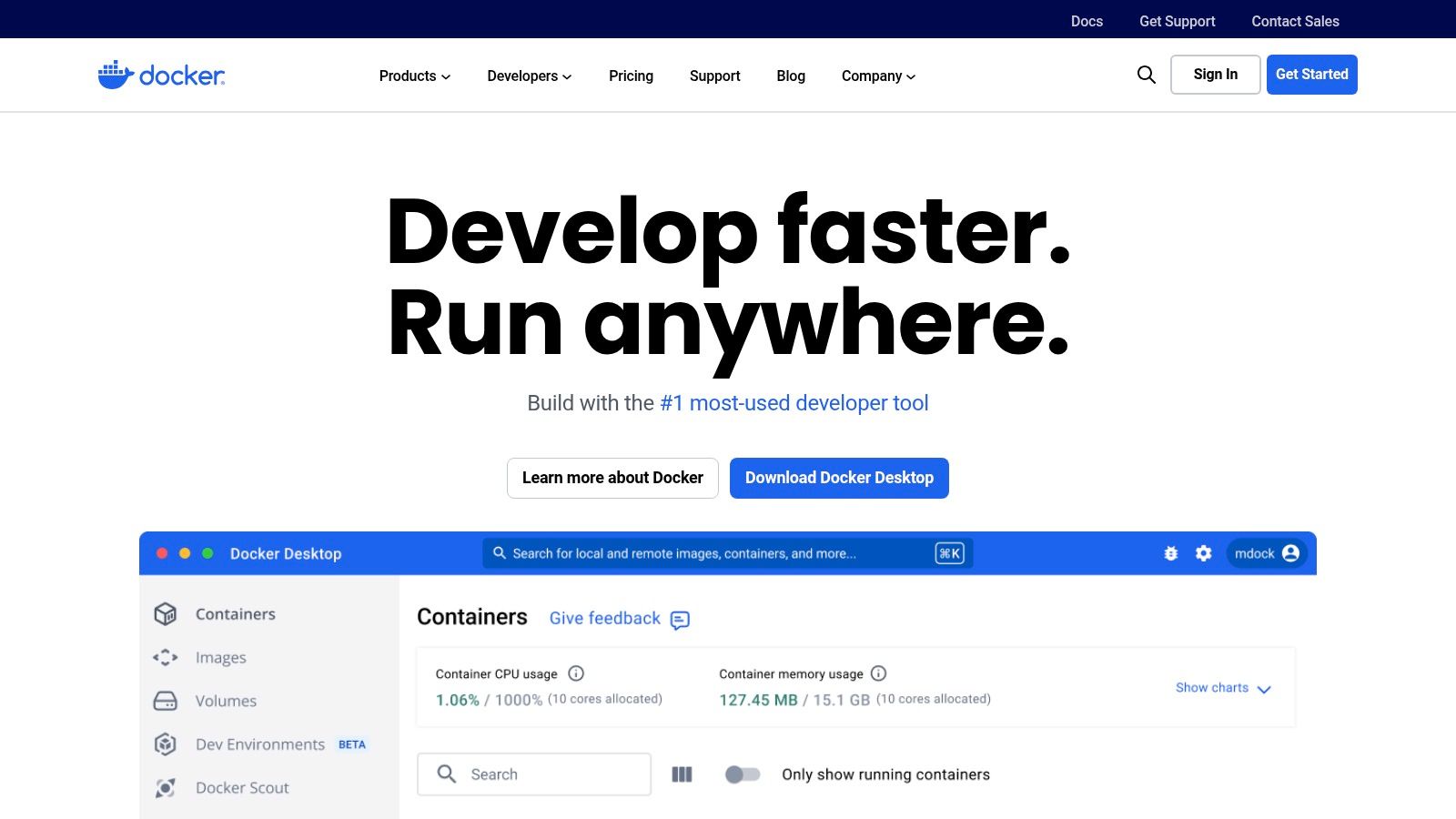
Its support for microservices architecture allows developers to break down applications into smaller, manageable services. This enhances scalability and resource utilization. While Docker Hub provides a central repository for sharing and managing container images, simplifying collaboration and deployment workflows. The free Community Edition caters to individual developers and small teams, while paid subscriptions offer advanced features for larger organizations.
Practical Applications
- Consistent Environments: Eliminate "works on my machine" issues by ensuring parity between development, testing, and production.
- Microservices Deployment: Simplify the deployment and management of complex microservices-based applications.
- CI/CD Integration: Streamline continuous integration and continuous deployment pipelines.
Pros and Cons
Pros:
- Environment Consistency
- Simplified Dependency Management
- Enhanced Scalability
- Microservices Support
Cons:
- Learning Curve for Beginners
- Container Management Overhead
Implementation Tips
Start with the Docker Desktop for local development. Familiarize yourself with basic Docker commands like docker build, docker run, and docker compose. Explore Docker Hub for pre-built images to accelerate development. Leverage Docker Compose for managing multi-container applications.
Docker is a powerful developer productivity tool. It significantly improves the efficiency of building, shipping, and running applications. Visit their website: https://www.docker.com/
7. Notion
Notion is an all-in-one workspace that streamlines developer workflows. It combines note-taking, project management, and real-time collaboration into a single platform. This allows developers to centralize their tasks, documentation, and communication, minimizing context switching and boosting productivity. Learn more about Notion and its capabilities.

Its highly customizable nature makes it adaptable to diverse project needs. From agile development sprints to design documentation, Notion's flexible templates and databases facilitate organized workflows. The rich media support, including code blocks and embeds, further enhances documentation and knowledge sharing within teams. While the free plan offers ample features for individuals, team collaboration benefits significantly from the paid plans, which unlock unlimited members and version history.
Practical Applications
- Project Planning: Organize tasks, deadlines, and progress tracking within a unified workspace.
- Documentation: Create and maintain detailed technical documentation, including code snippets and diagrams.
- Team Collaboration: Facilitate real-time communication and knowledge sharing within development teams.
Pros and Cons
Pros:
- Flexible and Customizable
- Centralized Workspace
- User-Friendly Interface
Cons:
- Can be Overwhelming for New Users
- Limited Offline Functionality
Implementation Tips
Start with a pre-built template relevant to your project needs (e.g., agile development, product roadmap). Customize the databases and views to match your specific workflow. Integrate relevant tools like GitHub and Slack to centralize all project-related information. Notion significantly enhances developer productivity by consolidating essential tools within a single platform. This fosters better organization, collaboration, and ultimately faster development cycles. Visit their website: https://www.notion.so/
8. Tabnine
Tabnine accelerates coding by offering AI-powered code completions directly within your IDE. It predicts and suggests your next lines of code, supporting multiple programming languages and integrating seamlessly with popular IDEs like VS Code, IntelliJ, and Eclipse. This real-time assistance boosts coding speed and reduces errors, allowing developers to focus on the logic rather than syntax. Offline functionality ensures privacy and uninterrupted workflow even without internet access.

Tabnine adapts to your coding style over time, learning from your projects and preferences. This personalized approach leads to more accurate and relevant suggestions, further enhancing productivity. While the free version offers basic code completion, the Pro tier unlocks more advanced features like whole-line and full-function completions, natural language to code conversion, and enhanced code security capabilities. The Pro plan starts at $12 per user per month.
Practical Applications
- Faster Coding: Quickly write code with AI-assisted completions.
- Reduced Errors: Minimize typos and syntax issues.
- Learning New Languages: Explore new languages with context-aware suggestions.
Pros and Cons
Pros:
- Increased Coding Speed
- Improved Code Accuracy
- Wide Language and IDE Support
- Customizable and Adaptive
Cons:
- Occasional Incorrect Suggestions
- Initial Learning Curve for Optimal Use
Implementation Tips
Install the Tabnine extension for your preferred IDE. Start with a small project to familiarize yourself with its suggestions. Explore the different customization options to tailor the tool to your coding style. Consider upgrading to the Pro version to unlock the full potential of AI-powered code completion and security analysis features.
Tabnine is a valuable developer productivity tool, especially for those working on large projects or learning new languages. It significantly speeds up the coding process and helps maintain code quality. Visit their website: https://www.tabnine.com/
9. Figma
Figma streamlines collaboration between designers and developers, boosting overall productivity. This cloud-based design tool allows for real-time collaboration on UI/UX designs, making it essential for agile workflows. Developers can access the latest design iterations, inspect elements, and extract code snippets directly, eliminating communication bottlenecks and reducing handoff friction. This accelerates development cycles and ensures design fidelity.
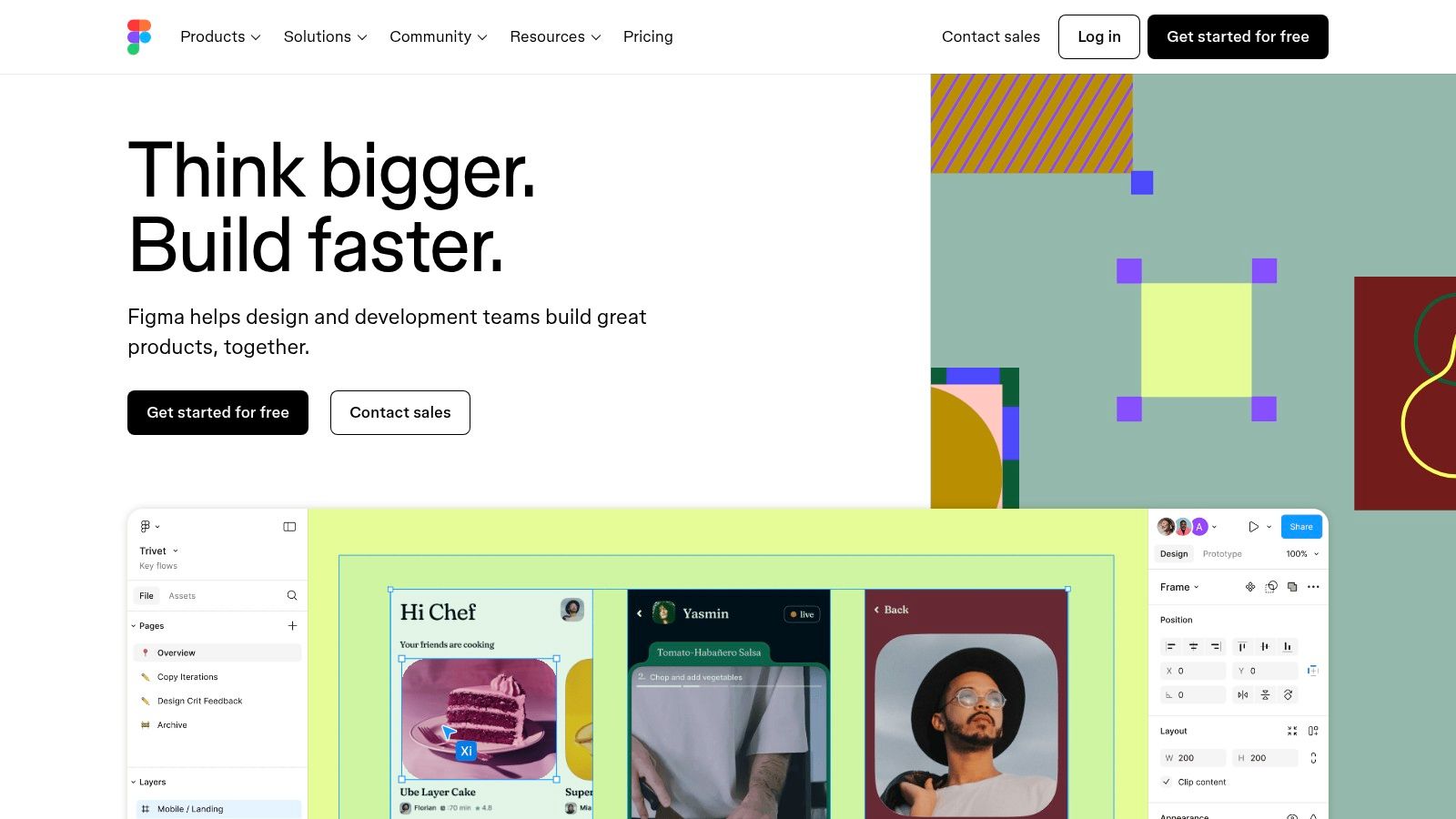
Figma's vector-based design tools, prototyping capabilities, and robust version control system contribute significantly to its efficiency. The extensive plugin ecosystem further extends its functionality, offering integrations with various developer tools and workflows. While the free tier provides ample features for individual users, the professional and organization plans unlock advanced collaboration and administrative features essential for teams. However, reliance on an internet connection can pose challenges in areas with limited connectivity.
Practical Applications
- Collaborative Design: Designers and developers work together seamlessly on UI/UX.
- Rapid Prototyping: Create interactive prototypes to test user flows and gather feedback.
- Design System Management: Maintain consistent design language across projects.
Pros and Cons
Pros:
- Real-time collaboration
- Cross-platform accessibility
- Robust version control
- Extensive plugin ecosystem
Cons:
- Dependence on internet connectivity
- Limited offline functionality
Implementation Tips
Integrate Figma into your existing design and development workflow. Utilize the collaborative features to facilitate real-time feedback. Leverage plugins to streamline design handoff and code extraction. Explore Figma's prototyping capabilities to create interactive mockups for user testing.
Figma is a powerful developer productivity tool that bridges the gap between design and development. Its collaborative features and comprehensive design toolset significantly improve workflow efficiency. Visit their website: https://www.figma.com/
10. Slack
Slack is a collaboration hub that streamlines team communication. It uses organized channels, direct messaging, and integrations with numerous apps and services. This allows for efficient communication and knowledge sharing within development teams. Slack centralizes discussions, eliminating the need for scattered email threads and fragmented conversations.
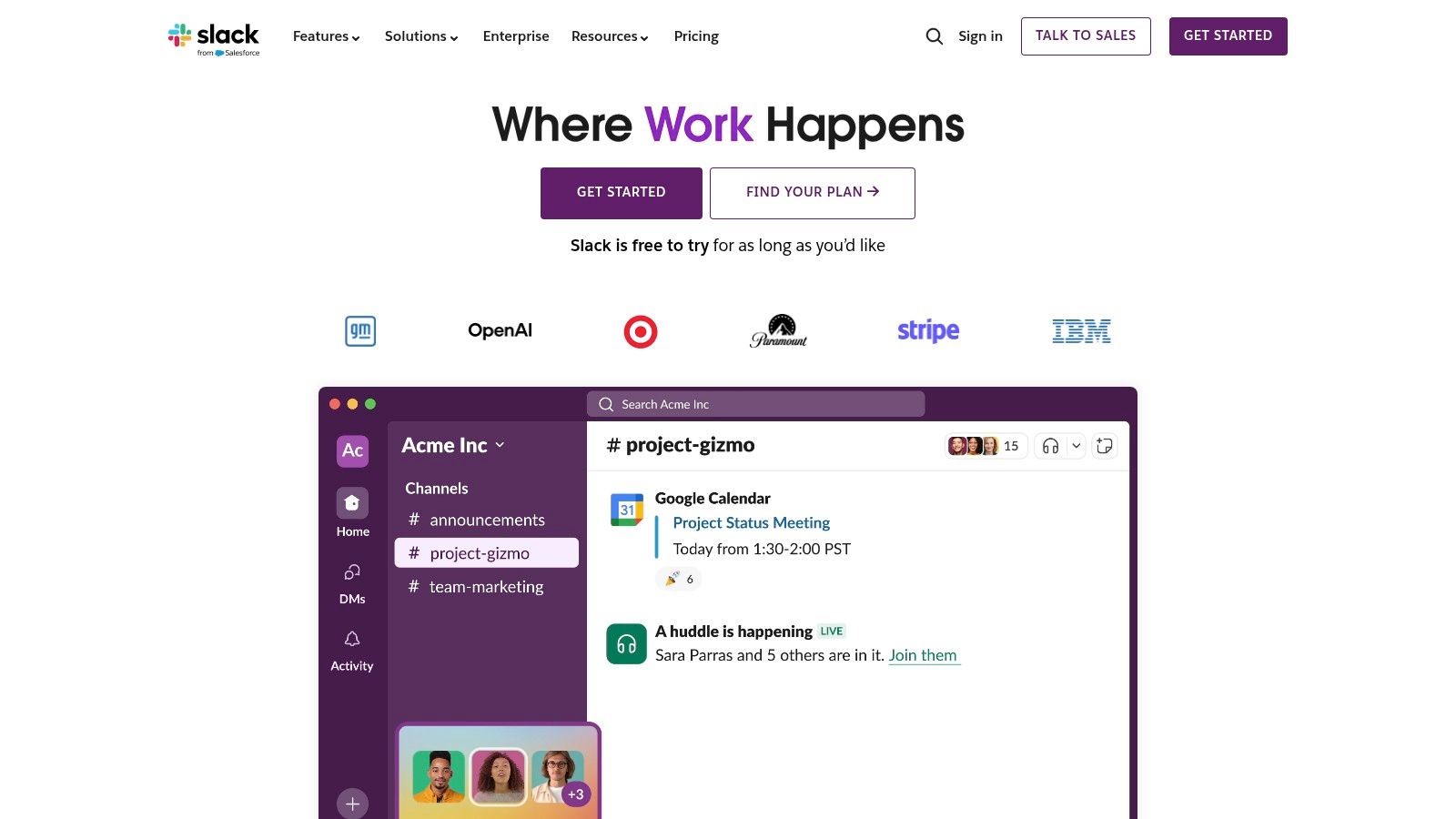
Its searchable message history provides a valuable archive of past discussions and decisions. The free version offers core features, while paid plans unlock unlimited message history, advanced search filters, and increased storage. Slack's user-friendly interface makes it easy to navigate and manage communication workflows. However, excessive channels can lead to information overload.
Practical Applications
- Project Management: Coordinate tasks, share updates, and track progress within dedicated channels.
- Code Collaboration: Discuss code snippets, troubleshoot issues, and share feedback in real time.
- Remote Team Communication: Bridge communication gaps and foster a sense of community among distributed team members.
Pros and Cons
Pros:
- Enhanced Team Communication
- Numerous Integrations
- User-Friendly Interface
- Searchable History
Cons:
- Potential for Channel Overload
- Limited History (Free Version)
Implementation Tips
Create dedicated channels for specific projects or topics. Integrate essential development tools like GitHub, Jira, and Trello for streamlined workflows. Utilize Slack's search functionality to quickly access past information. Establish clear communication guidelines to prevent channel clutter.
Slack is a powerful developer productivity tool. It significantly improves team communication and collaboration. Visit their website: https://slack.com/
11. Trello
Trello is a visual project management tool that uses boards, lists, and cards to help teams organize and prioritize projects. Its flexible and collaborative nature makes it adaptable to various workflows, from software development sprints to content calendars. Trello's drag-and-drop interface simplifies task management, allowing users to move tasks between lists as progress is made. This visual representation enhances workflow transparency and keeps everyone on the same page.
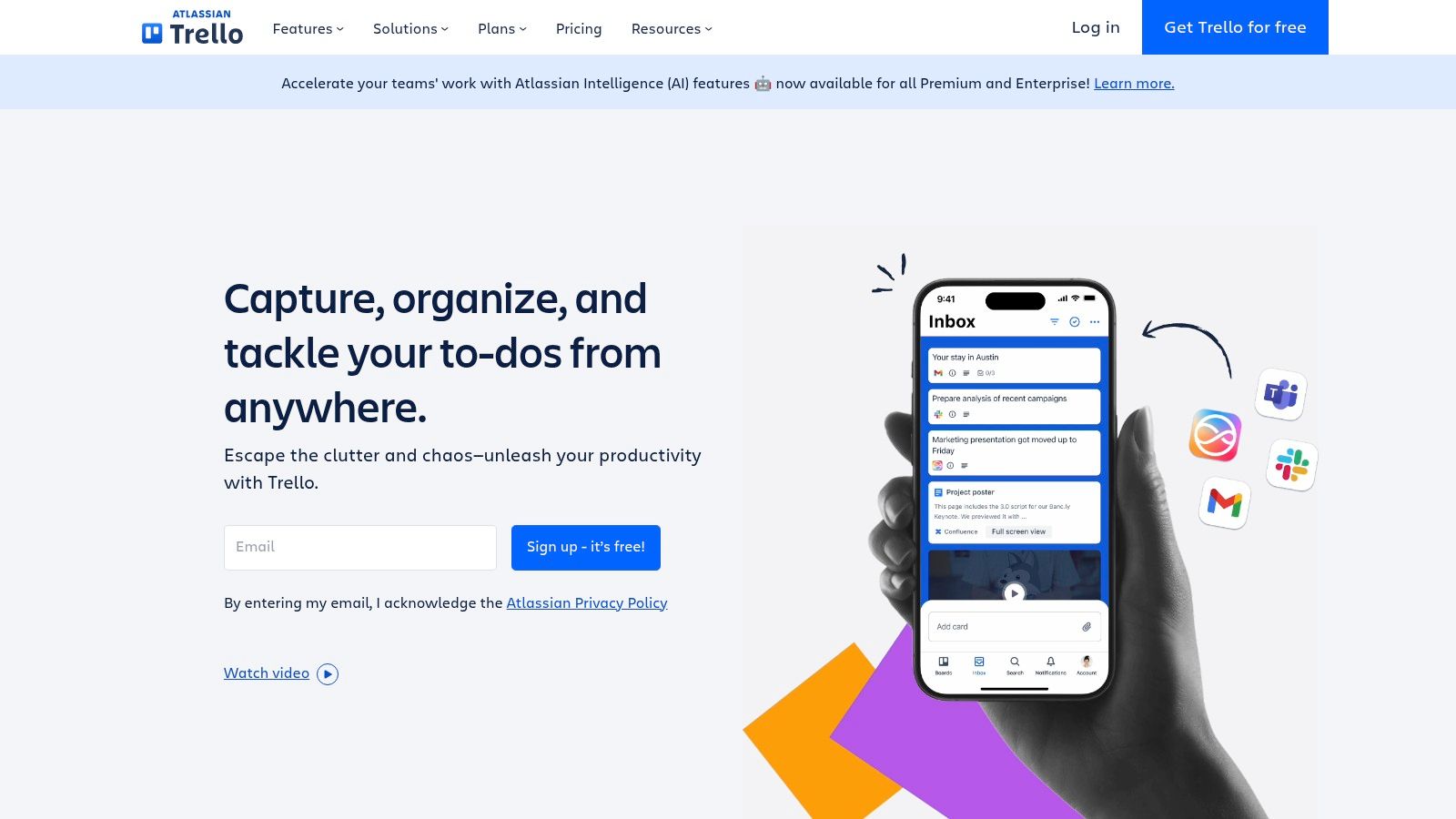
Trello integrates with a wide range of tools, including Slack, Google Drive, and GitHub, further streamlining workflows. Customizable workflows, comments, and attachments enhance collaboration and provide context for each task. While the free version is sufficient for basic project management, the paid versions offer advanced features like unlimited boards and advanced reporting, making it suitable for larger teams and complex projects.
Practical Applications
- Sprint Management: Organize development sprints with task assignments and progress tracking.
- Content Calendars: Plan and schedule content creation across multiple platforms.
- Bug Tracking: Manage bug reports and prioritize fixes within development cycles.
Pros and Cons
Pros:
- Intuitive interface
- Flexible workflow management
- Extensive integrations
- Enhanced team collaboration
Cons:
- Limited features in the free version
- May not be ideal for highly complex projects
Implementation Tips
Start with a simple board and a few lists to represent your workflow stages. Utilize labels and due dates to prioritize tasks. Integrate with other tools to centralize your workflow. Explore power-ups to extend Trello's functionality and tailor it to your specific needs. Trello is a versatile developer productivity tool that simplifies project management and enhances team collaboration. Visit their website: https://trello.com/
12. Postman
Postman is an API development environment that streamlines the entire API lifecycle. From design and testing to documentation and collaboration, Postman provides developers with the tools they need to work with APIs efficiently. I've used Postman extensively for testing REST APIs, building complex requests with various authentication methods, and generating documentation for team use. Its intuitive interface makes it easy to visualize API responses and debug issues quickly.
Its core features include robust API request building and testing, automated testing workflows, automatic API documentation generation, mock server creation, and collaborative workspaces. These tools combined significantly reduce the time spent on repetitive API tasks. For example, automated testing within Postman allows for continuous integration, catching potential errors early in the development process.
Practical Applications
- API Testing: Easily test API endpoints with various parameters and authentication methods.
- Documentation: Generate comprehensive API documentation automatically.
- Collaboration: Share collections and workspaces with team members for seamless collaboration.
Pros and Cons
Pros:
- Streamlined API Development Workflow
- Comprehensive Testing Capabilities
- Automated Documentation Generation
- Collaborative Workspaces
Cons:
- The free tier can be limiting for larger teams or complex projects.
- Alternative open-source tools may offer more customization options for advanced users.
Implementation Tips
Begin by organizing your API requests into collections. Leverage Postman's environment variables to manage different development stages (e.g., development, staging, production). Explore the Newman CLI for integrating Postman tests into your CI/CD pipeline.
Postman is an indispensable developer productivity tool, especially for those heavily involved in API development. It simplifies complex workflows and fosters efficient collaboration. Visit their website: https://www.postman.com/
Developer Productivity Tools Feature Comparison
| Product | Core Features / AI Capabilities | User Experience / Quality ★★★★☆ | Value Proposition 💰 | Target Audience 👥 | Unique Selling Points ✨ |
|---|---|---|---|---|---|
| 🏆 AnotherWrapper | 12+ AI demo apps, Next.js 15, Supabase, GPT-4o, DALL·E 3 | Enterprise-grade, customizable, clean code | One-time $229–$549, unlimited launches | Developers, founders, SaaS makers | Full-stack AI SaaS kit, 40+ Tailwind themes |
| GitHub Copilot | AI code suggestions, multi-language, VS Code integration | ★★★★☆ Real-time completions, context aware | Subscription-based, affordable | Developers coding AI & apps | AI-powered code completion, multi-lang support |
| Visual Studio Code | Code editor, extensions, Git, debugging | ★★★★★ Lightweight, highly extensible | Free | All developers | Extensive plugins, customizable |
| ClickUp | Task mgmt, workflows, automation, 1,000+ integrations | ★★★★☆ Feature-rich but complex | Freemium | Teams, project managers | Deep customization & automation |
| Jira | Agile tracking, Scrum/Kanban, reports | ★★★★ Complex but powerful | Paid (team-size based) | Agile software teams | Robust agile tools & integration |
| Docker | Containerization, CI/CD integration | ★★★★ Essential for DevOps | Free & paid tiers | Developers, DevOps | Portable containers, microservices support |
| Notion | Notes, project mgmt, customizable templates | ★★★★ Flexible, user-friendly | Freemium | Teams, individuals | All-in-one workspace, real-time collaboration |
| Tabnine | AI code completions, offline mode, multi-IDE | ★★★★ Learns user style, accurate | Subscription-based | Developers | Offline AI completions, customizable |
| Figma | Cloud UI/UX design, prototyping | ★★★★ Collaborative, browser-based | Freemium | Designers, developers | Real-time collaboration, no install needed |
| Slack | Team chat, channels, integrations | ★★★★ Improves communication | Freemium | Teams, organizations | App integrations, organized messaging |
| Trello | Visual task boards, drag-and-drop, collaboration | ★★★★ Simple & intuitive | Freemium | Small teams, project managers | Visual workflow, easy collaboration |
| Postman | API design/test, documentation, collaboration | ★★★★ Simplifies API lifecycle | Freemium | API developers | End-to-end API development workflow |
Elevating Your Development Game: Choosing the Right Tools
This curated list of 12 developer productivity tools offers a diverse range of solutions to streamline your workflow, from AI-powered coding assistants like GitHub Copilot and Tabnine, to project management powerhouses like ClickUp, Jira, and Trello. We've explored robust IDEs like VS Code, collaborative design tools like Figma, and essential communication platforms like Slack. Each tool comes with its own strengths and weaknesses, making it crucial to choose the right fit for your specific needs.
Key Takeaways for Enhanced Productivity
Remember, effective implementation is key to maximizing the benefits of any developer productivity tool. Here are some crucial takeaways:
- Context is King: The ideal tool depends on your project, team size, and personal preferences. VS Code excels for individual coding, while Jira shines in large-scale team projects.
- Integration is Essential: Smooth integration between tools is paramount for a cohesive workflow. Leveraging APIs and integrations can drastically reduce context switching and manual data entry.
- Experimentation is Encouraged: Don't be afraid to try different tools to find what works best for you. Many offer free trials or freemium versions, allowing you to explore their capabilities before committing.
Implementing Developer Productivity Tools Effectively
Consider these factors when implementing new tools into your workflow:
- Start Small: Begin with one or two tools and gradually integrate more as needed. Avoid overwhelming yourself with too many changes at once.
- Training and Onboarding: Ensure your team understands how to use the chosen tools effectively. Proper training can prevent frustration and maximize adoption.
- Regular Evaluation: Periodically review your toolset and assess its impact on your productivity. Are the tools still meeting your needs? Are there better alternatives available?
Choosing the Right Tools for Your Needs
Navigating the landscape of developer productivity tools can feel overwhelming. To simplify the selection process, consider the following:
- Project Scope: For small projects, simpler tools like Trello might suffice. Larger projects benefit from the robust features of Jira or ClickUp.
- Team Collaboration: If collaboration is a cornerstone of your work, tools like Slack, Figma, and Notion become invaluable.
- Coding Style: AI coding assistants like GitHub Copilot and Tabnine cater to different coding styles and preferences. Experiment to find the best fit.
Ultimately, the most effective developer productivity tools are those that seamlessly integrate into your workflow and empower you to build better software. By carefully evaluating your needs and experimenting with different options, you can create a powerful toolkit to elevate your development game and stay ahead of the curve. Embrace the power of these tools to enhance your efficiency, streamline your processes, and deliver exceptional results.
Streamlining API interactions is crucial for developer productivity. Want to simplify how you create and manage API wrappers? Check out AnotherWrapper for a streamlined solution that boosts your coding efficiency.
Fekri




